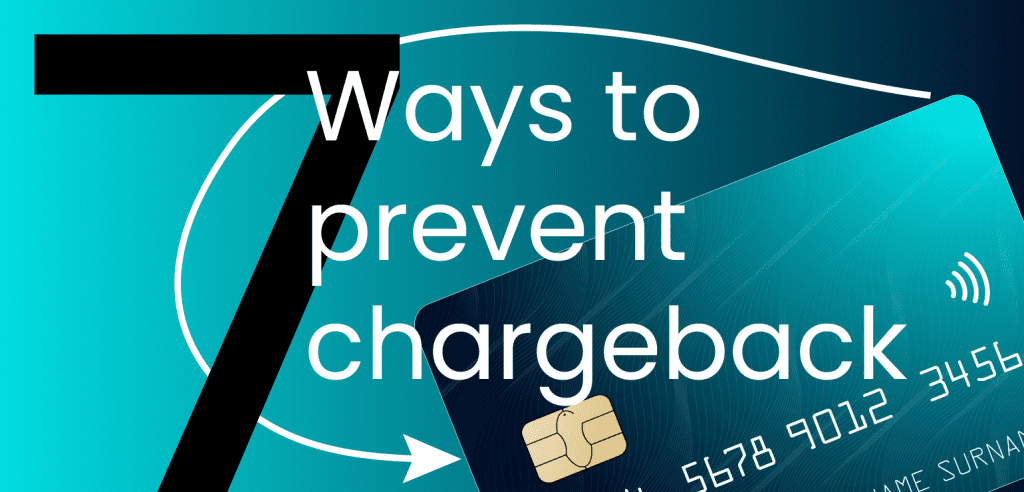7 ways to manage and prevent chargebacks on your eCommerce store

Article topics
- Make sure your customer service is on point
- Keep customers in the loop
- Choose a reliable courier
- Provide detailed product descriptions
- Make your return policy as hassle-free as possible
- Ensure brand name consistency
- Protect against chargeback fraud
There’s nothing more frustrating than getting a chargeback for an order on your online store.
Not only are there fees to pay, but you may have to spend time disputing payments that you think are incorrect or fraudulent. Plus, a high level of chargebacks can lead to negative reviews and even sanctions on your merchant account, like increased fees.
According to Statista, 2.7% of all online orders result in a chargeback, and the risk increases the larger your business is.
The good news is that there are steps you can take to reduce the risk of payment disputes. Here are seven ways to keep your chargeback rates low.
1. Make sure your customer service is on point
The difference between a refund and a chargeback is that a refund is processed directly by your eCommerce store. Meanwhile, a chargeback is carried out by the customer’s bank or credit card company.
Customers often initiate chargebacks as they can’t find a way to reach out to, or get a timely response from, an eCommerce store. So, the better the customer experience is, the more likely customers are to request a refund than a chargeback.
Provide as many communication channels as possible for customers to reach out, including email, phone, social media, and online chat. Let customers know when they can expect a response, and provide answers to frequently asked questions on your website.
2. Keep customers in the loop
Communication and transparency are everything in eCommerce – 90% of customers see quick, regular communication as an important factor.
Regular updates about their order will keep customers happy and help manage their expectations. It also provides a paper trail of evidence if you have to dispute a chargeback.
Let customers know when you’ve dispatched their order, when it’s with the courier, and when it will be delivered.
And, of course, give them a heads-up if there are any delays or issues.
3. Choose a reliable courier
It’s essential to work with a reliable delivery partner. They’ll ensure your products don’t get lost or damaged in transit, deliver them quickly, and provide proof of delivery – essential in the case of a dispute.
Take reputation and experience into consideration rather than just price – and don’t forget to read the reviews!
4. Provide detailed product descriptions
Chargebacks often occur because the products ordered and dispatched were not as described.
This means providing detailed and accurate information, as well as high-quality product photos, can increase the chance of customers getting the items they want.
Adding reviews and ratings to product pages also provides shoppers with additional information about whether an item is right for them.
If you have a lot of products on your website, a product information management (PIM) system will make managing your page content easier.
5. Make your return policy as hassle-free as possible
Returning products can be a hassle, especially when dealing with an online store. This increases the chances of customers filing a chargeback.
In fact, four out of five people say they’ve filed a chargeback because it was the most convenient thing to do.
You can reduce the risk of this happening by making your return policy as frictionless as possible.
- Have a clear, jargon-free policy that’s easy to find on your website and linked to in all emails you send
- Provide multiple return options, for example, the option to return in-store or through a locker service
- Offer free returns (although this isn’t always a sustainable option)
- Process returns and payments as quickly as possible
6. Ensure brand name consistency
Sometimes your business can appear differently on customers’ bank and credit card statements, for example, if you trade under an alternative name.
This can result in customers believing they’re a victim of card fraud, leading them to file a dispute with their payment provider.
Make sure you use your eCommerce store name when requesting payment. If this isn’t an option, add a section to your website explaining the discrepancy. That way, if a customer searches online, they’ll see that the charge has come from you.
7. Protect against chargeback fraud
Chargeback fraud is when a customer submits a payment dispute despite having no issues with the product. For example, a client may place an order and claim they never received it, even though they did.
It’s estimated that over half of chargebacks are fraudulent.
Here are some ways you can protect your business from chargeback fraud.
- Look closely at orders before you action them. For example, if a new customer has ordered many high-value items or placed several orders in a short amount of time, these could be red flags
- Set up ‘velocity limits’ in your online store. A velocity limit flags an action that occurs in a specific timeframe and implements a response. For example, if a customer fails to submit the correct payment details five times in the space of five minutes, you can block them from placing an order for 24 hours
- Confirm orders before and after a sale – this provides evidence in case a customer files a claim
- Set up an exclusion list for customers that have committed fraud before. Remember that you have the right to refuse service, as long as it’s not on the grounds of a protected characteristic like gender or age
- Ensure you’re compliant with PCI DSS – this will provide an extra layer of protection against fraud
Want to build your eCommerce store so it’s secure and provides you and your customers with peace of mind? Contact our expert web development team today.


 Back
Back
